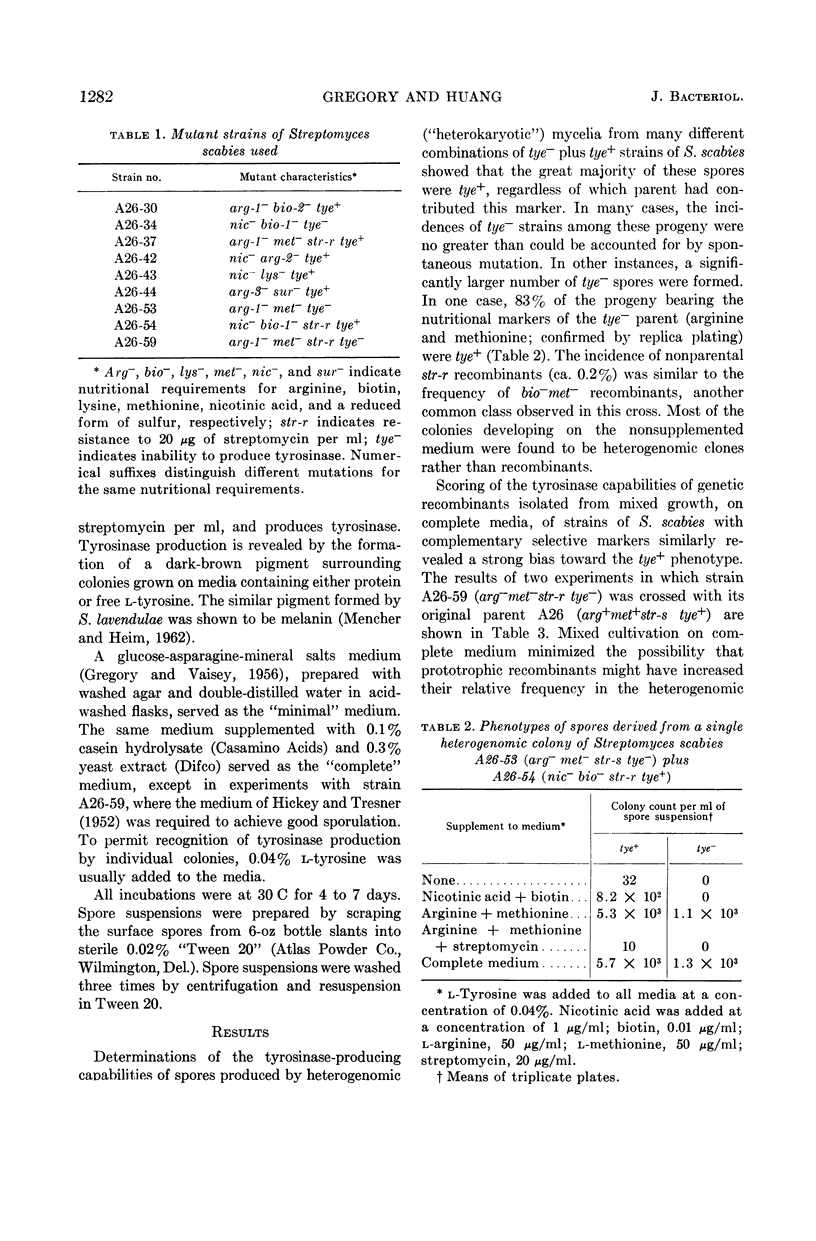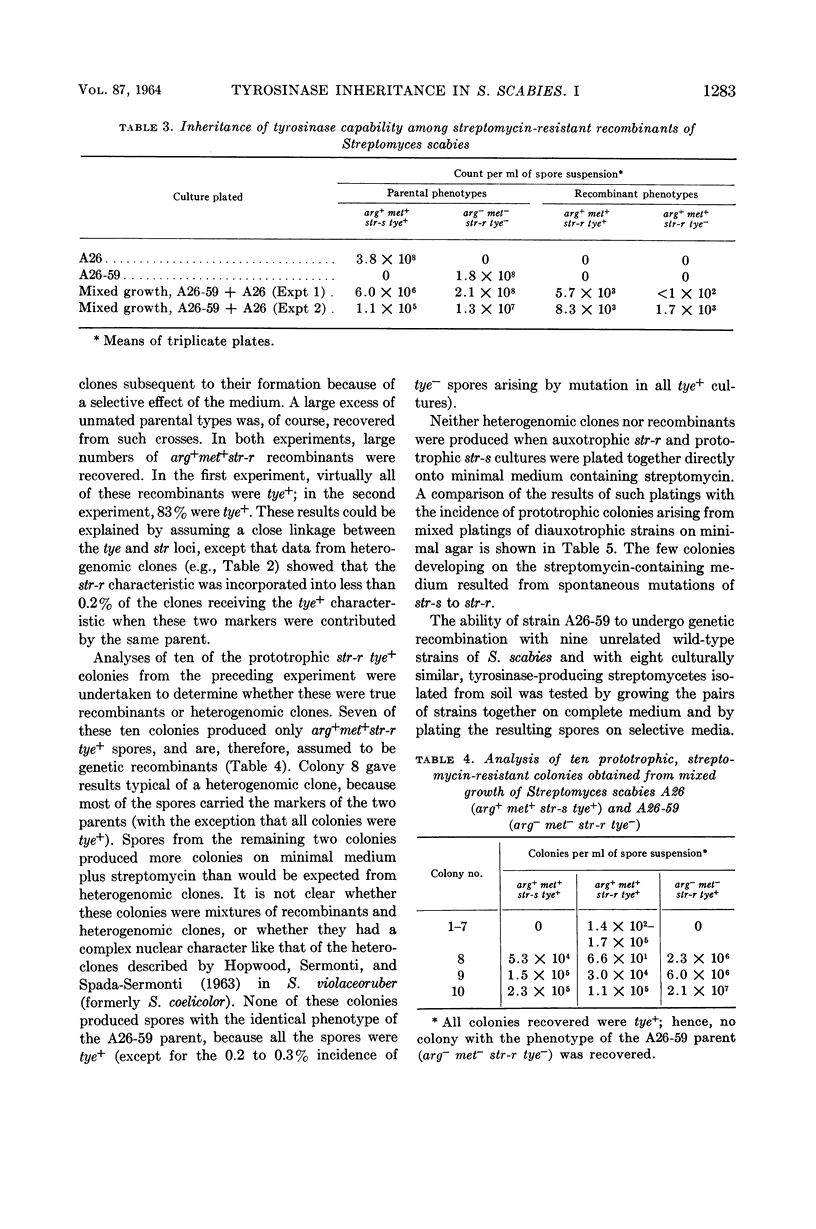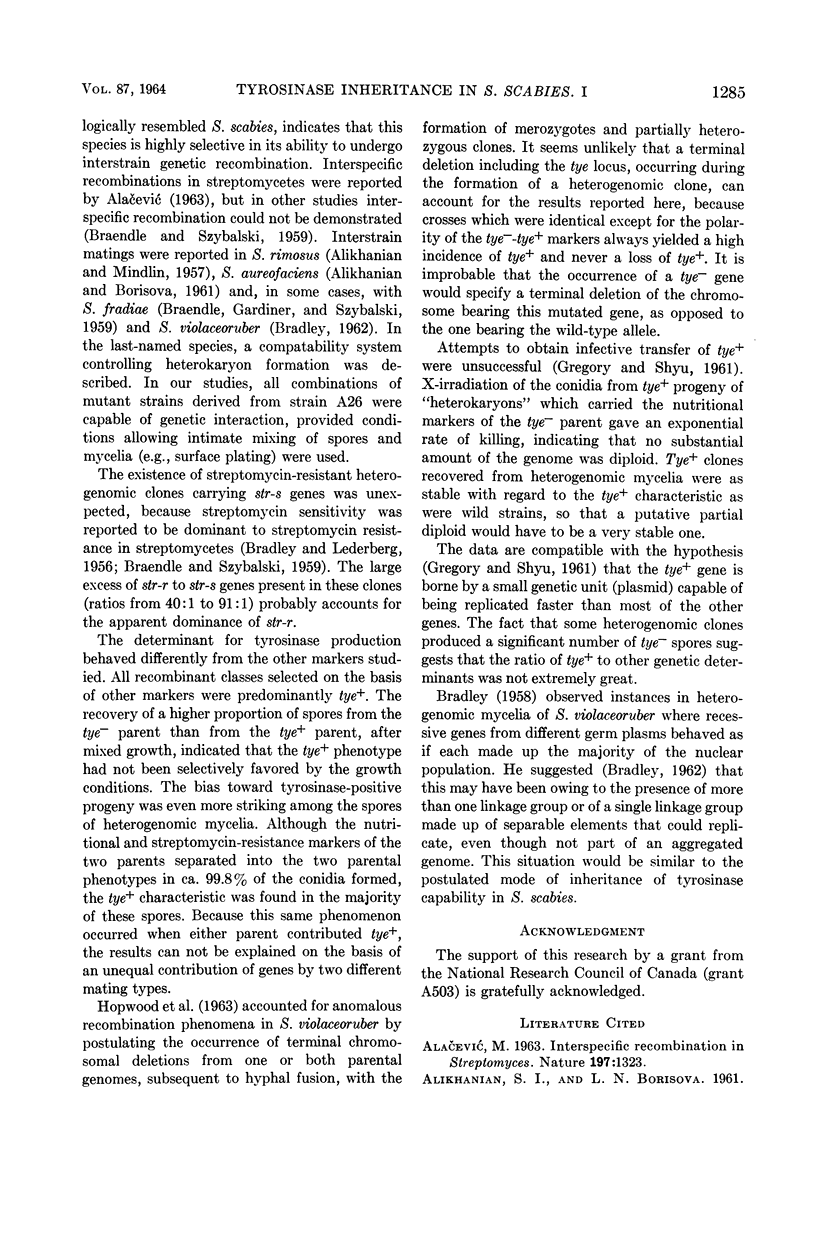Abstract
Gregory, Kenneth F. (Ontario Agricultural College, Guelph, Ontario, Canada), and Jay C. C. Huang. Tyrosinase inheritance in Streptomyces scabies. I. Genetic recombination. J. Bacteriol. 87:1281–1286. 1964.—Mutants derived from Streptomyces scabies strain A26 recombined with other derivatives of A26, but not with nine other strains of S. scabies nor with eight strains of other streptomycetes. Most of the spore progeny of heterogenomic mycelia formed from complementary diauxotrophic strains of S. scabies A26 were capable of forming tyrosinase (tye+), provided either of the parents was tye+. About 99.8% of these spores carried the nutritional markers of either one or the other of the two parents. All recombinant classes between nutritional and streptomycin susceptibility markers were like-wise predominantly tye+. We suggest that the tye+ characteristic is carried in a small genetic unit, which is unlinked to most other genes and capable of replicating faster than the rest of the S. scabies genome.
Full text
PDF





Selected References
These references are in PubMed. This may not be the complete list of references from this article.
- ALACEVIC M. Interspecific recombination in Streptomyces. Nature. 1963 Mar 30;197:1323–1323. doi: 10.1038/1971323a0. [DOI] [PubMed] [Google Scholar]
- ALIKHANIAN S. I., BORISOVA L. N. Recombination in Actinomyces aureofaciens. J Gen Microbiol. 1961 Sep;26:19–28. doi: 10.1099/00221287-26-1-19. [DOI] [PubMed] [Google Scholar]
- ALIKHANIAN S. I., MINDLIN S. Z. Recombinations in Streptomyces rimosus. Nature. 1957 Nov 30;180(4596):1208–1209. doi: 10.1038/1801208a0. [DOI] [PubMed] [Google Scholar]
- BRADLEY S. G., LEDERBERG J. Heterokaryosis in Streptomyces. J Bacteriol. 1956 Aug;72(2):219–225. doi: 10.1128/jb.72.2.219-225.1956. [DOI] [PMC free article] [PubMed] [Google Scholar]
- BRADLEY S. G. Parasexual phenomena in microorganisms. Annu Rev Microbiol. 1962;16:35–52. doi: 10.1146/annurev.mi.16.100162.000343. [DOI] [PubMed] [Google Scholar]
- BRAENDLE D. H., GARDINER B., SZYBALSKI W. Heterokaryotic compatibility in Streptomyces. J Gen Microbiol. 1959 Apr;20(2):442–450. doi: 10.1099/00221287-20-2-442. [DOI] [PubMed] [Google Scholar]
- BRAENDLE D. H., SZYBALSKI W. Heterokaryotic compatibility, metabolic cooperation, and genic recombination in Streptomyces. Ann N Y Acad Sci. 1959 Sep 30;81:824–853. doi: 10.1111/j.1749-6632.1959.tb49369.x. [DOI] [PubMed] [Google Scholar]
- GREGORY K. F., SHYU W. J. Apparent cytoplasmic inheritance of tyrosinase competence in Streptomyces scabies. Nature. 1961 Jul 29;191:465–467. doi: 10.1038/191465a0. [DOI] [PubMed] [Google Scholar]
- GREGORY K. F., VAISEY E. B. Pathogenicity of tyrosinase-deficient mutants of Streptomyces scabies. Can J Microbiol. 1956 Apr;2(2):65–71. doi: 10.1139/m56-010. [DOI] [PubMed] [Google Scholar]
- HICKEY R. J., TRESNER H. D. A cobalt-containing medium for sporulation of Streptomyces species. J Bacteriol. 1952 Dec;64(6):891–892. doi: 10.1128/jb.64.6.891-892.1952. [DOI] [PMC free article] [PubMed] [Google Scholar]
- HOPWOOD D. A., GLAUERT A. M. The fine structure of Streptomyces coelicolor. II. The nuclear material. J Biophys Biochem Cytol. 1960 Sep;8:267–278. doi: 10.1083/jcb.8.1.267. [DOI] [PMC free article] [PubMed] [Google Scholar]
- HOPWOOD D. A., SERMONTI G., SPADA-SERMONTI I. Heterozygous clones in Streptomyces coelicolor. J Gen Microbiol. 1963 Feb;30:249–260. doi: 10.1099/00221287-30-2-249. [DOI] [PubMed] [Google Scholar]
- MOORE R. T., CHAPMAN G. B. Observations of the fine structure and modes of growth of a streptomycete. J Bacteriol. 1959 Dec;78:878–885. doi: 10.1128/jb.78.6.878-885.1959. [DOI] [PMC free article] [PubMed] [Google Scholar]


